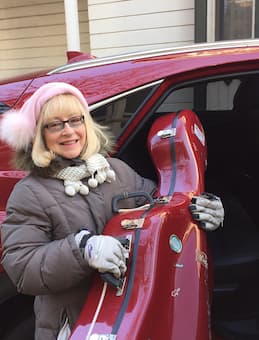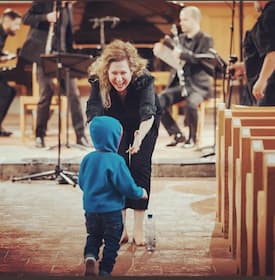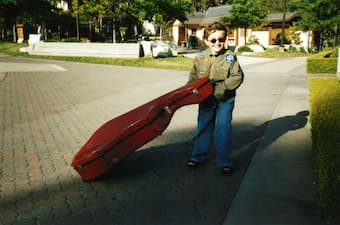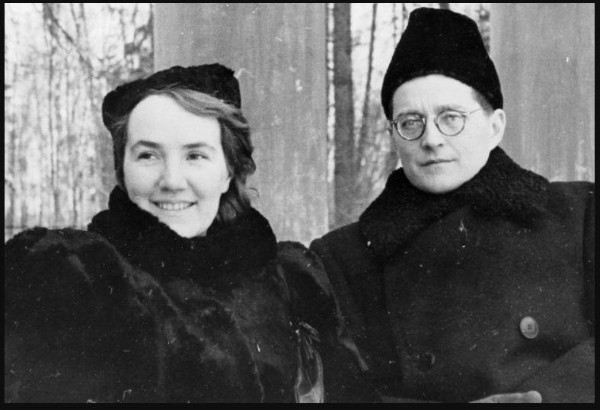
Janet Horvath
My two-year old wasn’t feeling well. “Mommy don’t go,” he whined. I had already donned my long black satin dress. Looking nervously at my watch I realized that it was very near concert time. I bent over to pick him up and he promptly threw up all over me.
I remember the years of sleepless nights—the overnight feedings and diaper changes later morphing into hustling to get my son dressed, fed, and off to school with a home-made and packed lunch. My husband would drive Harris to school while I grabbed my triple espresso and my cello, and I’d drive to Orchestra Hall for a double rehearsal (that is, two rehearsals in one day from 10:00 a.m. to 3:35 p.m.) With impeccable timing, (perhaps a bit of speeding?) I’d arrive thirty minutes before the rehearsal. And did I say that the concert the night before ended at 10:30 p.m.?
Other days our schedule called for a morning rehearsal and an evening concert. In the afternoon there would be ‘civilian’ tasks such as grocery shopping, banking, and picking my son up at school. Bleary eyed, I’d try to help with homework, prepare dinner, and race back to the hall for the evening concert, looking glamorous, at ease, and playing every note in the music. As associate principal cello, I was expected to do no less.
Schumann: Cello Concerto (Truls Mørk, cello; NHK Symphony Orchestra; Paavo Järvi, cond.)

Gwendolyn Masin at the GAIA festival and son Sara Timar
One summer I had the privilege of being the soloist in Schumann’s Cello Concerto with the Minnesota Orchestra but my husband happened to be away on business. Frantically, I juggled car pools and babysitters. My son was an active toddler at the time and my tween stepdaughter had volleyball camp and activities with her friends. Certainly, there was no time for pre-concert jitters. On the day of the performance, a friend noticed the enormous bags under my eyes. She offered her apartment for the afternoon. Several yoga moves combined with strong positive visualizations and deep breathing worked wonders.
For busy households with small children, just as with many other jobs, arriving at the first orchestra rehearsal knowing one’s own part cold is a challenge. Orchestras go through an enormous amount of repertoire, which varies week to week. Busy parents seldom have the luxury of even one hour of uninterrupted time. Practicing, staying in shape, and learning the music are still required. How then do we maintain our stressful careers?
Our practice needs to be much more efficient wherever and whenever we can squeeze it in. Some of my colleagues, whose children had bedtimes on the earlier side, practiced after everyone was asleep—tricky if you live in a townhouse or condominium. This didn’t work for me! My son never went to bed…or so it seemed. Other colleagues practiced before anyone else was up in the morning. I’m not a morning person. A few musicians stayed after the concerts, and they practiced at the hall into the wee hours. That didn’t work for me either.

Anne Akiko Meyers with Natalie, 2012 © violinist.com
I devised a 30-minute warm up in the morning before rehearsals for my technical “house-cleaning”—working on my intonation, sound quality, difficult bowings, and general facility, and later in the day I’d squeeze in forty-five minutes after rehearsal or during lunch hour.
On concert days, I planned my schedule with military precision. Practice 4:30 to 5:30; dinner prep 5:30 to 6:00. Eat promptly at 6:00. Dress and doll myself up 6:30 to 6:45 (it would have to do…). In the car 6:45. Hall arrival 7:15, which gave me fifteen minutes to get into my gown and shoes, and maybe grab a cup of strong coffee. Winter in Minnesota is not for sissies. One has to don heavy down jackets, hefty boots, lined mittens, snow pants and a hood (too bad about “hat hair”) and peel it all off. I was typically onstage by 7:30 for the 8:00 p.m. concert. Breathe…
Once you have a family, practicing has to become an extreme sport—compressed, focused, deliberate, and analytical—your expertise at eyeballing a piece of music, ferreting out the troublesome parts, and zeroing in on these spots—finely honed.
Here are a few hints:
Felix Mendelssohn: Symphony No. 4 in A Major, Op. 90, MWV N16, “Italian” – IV. Saltarello: Presto (Bavarian Radio Symphony Orchestra; Colin Davis, cond.)
Warm up. Pieces like Mendelssohn Italian Symphony especially the Saltarello: Presto movement for which we need to be nimble-fingered or tongued, or complex contemporary pieces like Kaija Saariaho’s L’Amour de Loin or Béla Bartók Miraculous Mandarin, with large forces and huge percussion sections, are virtually unplayable without a proper warm up especially if you haven’t had as much practice time as you’d like. Injury is a possibility when your motions are jerkier.
Kaija Saariaho: 5 Reflets de L’Amour de loin (5 Reflections on Love from Afar)No. 3. L’Amour de loin (O Distant Love) (Gabriel Suovanen, baritone; Finnish Radio Symphony Orchestra; Jukka-Pekka Saraste, cond.)
Béla Bartók: The Miraculous Mandarin, Sz. 73, Op. 19 – The girl begins a hesitant dance… (Bournemouth Symphony Orchestra; Marin Alsop, cond.)
Béla Bartók: The Miraculous Mandarin, Sz. 73, Op. 19 – The Mandarin stumbles – the chase becomes even more passionate (Bournemouth Symphony Orchestra; Marin Alsop, cond.)
Béla Bartók: The Miraculous Mandarin, Sz. 73, Op. 19 – The three tramps leap out, seize the Mandarin and tear him away from the girl (Bournemouth Symphony Orchestra; Marin Alsop, cond.)
Focus your attention on the passages that are exposed, and easily heard. If you are a wind or brass player you are heard all the time of course, but there are passages where your instrument has the main line or tune. Isolate these phrases. If you are performing an unfamiliar work take the time to listen to it while studying the music. This will make your practice time much more efficient.
Isolate the bars with tricky rhythms. Make certain to figure them out slowly and with a metronome. Count carefully.

Harris with cello case
If you haven’t had much sleep your pencil markings are indispensable—grand pauses, changes of meter, bars of rest, repeated patterns, sudden changes of tempo, key changes and accidentals, should all be flagged. Don’t be embarrassed about putting in some fingerings, and when you’re playing, make sure to keep looking ahead in the music. In the few moments before a concert quickly review the complex passages, flipping through the music to check the time signatures, key signatures, tempo markings, and the specific instructions the conductor gave in rehearsals.
It’s become much easier now that prominent orchestral musicians and soloists have gone public about the challenges of being a pro and a parent. One day your child will attend one of your concerts, insist on carrying your instrument for you, and you may even hear, “That’s my mommy playing. She practices hard.”
For more of the best in classical music, sign up to our E-Newsletter



